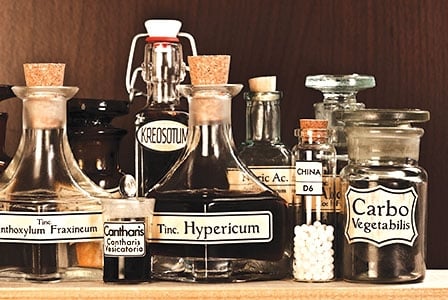
What do Mark Twain, John D. Rockefeller, Cindy Crawford and Usain Bolt, the fastest man in the world, all have in common? Why, homeopathy of course.
A system of natural medicine
Homeopathy, derived from the Greek words meaning “similar” and “suffering,” is a system of medicine founded by German physician Samuel Hahnemann (1755 to 1843).
Homeopaths believe in the Law of Similars, which states that “like cures like.” By this rule, a substance that would normally create symptoms in a healthy person can help treat a sick person with those same symptoms, when given in a very small dose.
Homeopathy uses remedies made from natural sources derived mostly from plants and minerals, though some have animal sources such as venoms. Unique to homeopathy, these natural remedies begin as a liquid tincture, then go through a potentisation process of dilution and succussion (shaking) to render them nontoxic, minimise side effects and increase their healing power.
This process of potentisation means they are safe for adults, children, the elderly and even animals. Remedies are typically administered in tablet form, though for external use they can be compounded as creams, sprays or gels.
Homeopathy treats the whole person
To effectively use homeopathy, it’s best to take the whole person into consideration. For example, two people who both have headaches but who are experiencing different symptoms require their own unique homeopathic remedies.
- Someone who has violent throbbing head pain that’s relieved with pressure may benefit from Belladonna.
- The person who has a pulsating headache accompanying stiff neck and shoulders may benefit from Spigelia.
Homeopathy for first aid
Homeopaths use more than 6000 remedies. The largest group of remedies is derived from plants such as
- mountain daisy (Arnica montana) to help speed healing after bruises, sprains and strains
- marigold (Calendula officinalis) to help heal injury to skin
Homeopathy for children
Colic, teething, earaches, coughs and colds can all be soothed with homeopathy. Two remedies that are most popular with parents:
- Pulsatilla may be used for the child who’s tearful and needs affection while unwell
- Chamomilla for the child who’s angry, impatient and desires to be carried while sick
Homeopathy for long-standing illnesses
The Charité University Medical Centre in Germany conducted a study involving 134 adult patients with chronic sinusitis. Researchers found patients experienced a “marked” improvement in their quality of physical and mental health following homeopathic treatment, and the effects lasted for as long as eight years.
Homeopathy for Royal animals
The British royal family has been using homeopathy since 1830; currently Peter Fisher is their homeopathic physician. Her Majesty The Queen always travels with her homeopathic medicines and even uses them with her dogs. According to a news report, when asked why she used a homeopathic ointment on her corgi’s cut foot she replied, “If it’s good enough for me, it should be good enough for my dogs.”
Homeopathy for emotional support
Ignatia is a remedy used to support emotional turmoil, especially grief that may lead to insomnia and tearfulness. While grief itself is a natural human emotion, homeopathy can help relieve emotional states that are prolonged or debilitating.
Homeopathy’s Australian legacy
According to local archives, homeopathy has been practised in Australia for more than 160 years. Famous early homeopathic doctors in the colonies were John B Hickson, Thiennette de Bérigny and Robert Ray. Dr Johannes W Günst, who opened the first hydropathic institutions in both Sydney and Melbourne, was world-famous for his work with Indigenous people and was awarded the Legion of Honour in Paris.
While there had been homeopathic dispensaries in Australia as far back as the 1850s, it was in 1855 that homeopathic pharmacist Mr Kinder went into business with Edward G. Gould, who in turn was joined by R.H. Martin. Charles Pleasance joined Martin in 1882, and the firm became Martin & Pleasance—although no longer family-owned, they remain a renowned homeopathic supplier in Australia today.
Did you know?
- Samuel Hahnemann has his burial monument in the famous cemetery Père Lachaise in Paris, France, among many others famous for their contributions to culture, science and humanity. A great bronze relief in Washington, DC, also honours his lifelong contributions as a chemist, physician and founder of homeopathy.
- In Australia, most major health funds currently provide coverage for homeopathic treatment, depending on the patient’s level of insurance. In Europe, approximately 45,000 medical doctors are trained in homeopathy, and national laws recognise homeopathy as a distinct therapeutic system in countries such as Belgium, Germany and the United Kingdom.

